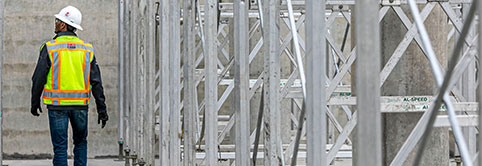Focus on Flow
Introduction to Focus on Flow
In the design and construction industry, one of the biggest burdens on project timelines is a lack of process flow. Teams and their members are constantly stuck waiting around for work to be completed by someone else, whether it’s a hand-off that needs to happen, parts that need to arrive, or work that got delayed, thus backing up the overall schedule.
This harkens to one of the eight wastes of Lean: Waiting. Time is of the essence when it comes to construction projects, since wasted time is literally wasted money and production flushed down the drain.
Waste has unfortunately become a norm in the industry – something that many have become accustomed to. People in the industry understand that working on a construction project entails working with other teams, and even though the same problems crop up again and again on each new project, processes rarely shift to address them.
One of the easiest methods for addressing waste is to focus on project flow, ensuring that processes are put together in a way that considers everyone’s role in the project and what they need to begin or finish their work.
Additionally, some steps in a process may be wasteful in nature. Anything that does not directly create value is waste. Processes are replete with wasteful steps that could be removed or reimagined if the team focused on flow.
What is Focus on Flow?
Focus on Flow is the shift towards a process that includes smooth, unimpeded handoffs between and among project team members from one crew to the next.
What Does Focus on Flow Entail?
Lean Construction takes many cues from the manufacturing industry. In Lean manufacturing, an item on a product line moves smoothly from one station to the next. Items spend very little if any time waiting for the next step to occur, so value is consistently being added with minimal pauses or stoppages.
Construction is a different beast from manufacturing to be certain, but processes can similarly be improved by focusing on flow and ensuring that people, tools, and materials spend as little time as possible waiting for something else to happen.
Focusing on Flow entails…
- Training team members to see waste in the workflow and to identify places where waiting and other types of waste are occurring.
- Recognizing and eliminating steps in the project process that are unnecessary or wasteful.
- Setting up a consistent and simple flow of communication so waste can be communicated and eliminated, and for providing team members with the opportunity to communicate last-minute changes.
- Adjusting workflow processes by focusing on the end outcome and working backwards from there to determine what steps need to be taken to get to that outcome.
- Fostering a system of trust and communication between team members to reduce and eliminate waiting steps and to plan hand-offs efficiently.
- Using the Conditions of Satisfaction to drive the workflow.
Benefits of Focusing on Flow
1. Time
With an improved flow, waiting times and wasteful steps are reduced or eliminated, allowing the project to be completed on a faster and more efficient timeline.
This saved time not only equates to saved money for each team involved in the project, it also allows the team more time to implement innovative ideas that add additional value to the project.
2. Morale
When team members are stuck waiting for their part of the project to begin or end, morale can easily take a hit. Team members may lose motivation as frustrations mount.
With a smooth workflow, team members will feel more productive as they’re able to spend more time doing work that adds value to the project. This increased morale will help teams feel that their work matters, driving them to work harder.
3. Team Chemistry
When hand-offs are not completed smoothly, team members will start pointing fingers and blaming one another for not being able to get their part of the work done.
With improved communication and smoother hand-offs, these instances are eliminated, and team members will start to trust one another more once they see that other people are capable of keeping the promises that they make.
4. Value
In the end, every decision made in a project should be with one ultimate goal in mind: Value.
Each time waste is eliminated from a process, value increases. Focusing on flow eliminates waste and makes projects more efficient, adding a substantial amount of value to the project on the whole.
How to Focus on Flow
1. Observe
To focus on flow, team members must be observant of what is happening around them. To improve processes, you first must notice where waste is occurring. Then, you can begin to plan changes to the workflow to eliminate that waste.
2. Communicate
To enact real change in a project utilizing Lean concepts, the team must be committed and involved. No one person can do it alone.
Set up strong lines of communication within and between project teams so people can discuss process improvements and hand-offs as the project progresses.
3. Utilize Lean Methods
Kanban
Kanban is one of the most popular and effective ways to improve project flow. Kanban boards allow team members to visually see where each work item is along the line of production. This helps to limit the number of work items in progress and the number of items that are stuck waiting for something else to happen.
Value Stream Mapping
Value Stream Mapping is a practice where team members get together to map out the value stream of the project, determining what needs to happen to get to the final outcome. This is an easy way to visualize wasteful steps that can be eliminated and identify the “stations” of the production flow.
Gemba Walks
Gemba walks are conducted by team leaders and are a way to check processes for waste. These also allow team leaders to identify areas where the process is not working as intended so they can improve it.
Daily Huddles
Daily Huddles improve flow by allowing team members the daily opportunity to raise issues, coordinate hand-offs, and determine what work they will need to complete on that day to keep the flow moving forward.
Andon
Andon is a system for declaring breakdowns in a process. Setting up a proper Andon system prepares teams for what to do if something goes wrong, allowing the team to quickly correct the issue so the flow can continue unimpeded.
5S
5S is a mindset for organization and cleanliness in the workplace. A clutter-free and well-organized workspace makes everyone’s job easier, and flow is improved when team members can easily find what they need.
More Lean Topics
From 5s to IPD, explore popular Lean design and construction topics below.





